Physical Address
304 North Cardinal St.
Dorchester Center, MA 02124
Granulomatous peritonitis, which can be caused by a variety of infectious and noninfectious agents, can result in peritoneal nodules, potentially mimicking disseminated cancer. Most of the following show a histiocytic response that may be to varying degrees granulomatous.
Peritoneal tuberculosis, which is not uncommon in developing countries, can mimic advanced ovarian cancer both clinically (pelvic masses, ascites, elevated CA125) and intraoperatively.
Other less common infectious causes include fungal infections (histoplasmosis, coccidioidomycosis, cryptococcosis) and parasitic infestations (schistosomiasis, oxyuriasis, echinococcosis, ascariasis, strongyloidiasis).
Noninfectious causes include:
Foreign material such as starch granules from surgical gloves, douche fluid, and lubricants; talc (from surgical gloves or in drug abusers); cellulose and cotton fibers from surgical pads and drapes; microcrystalline collagen hemostat (Avitene); oily materials (hysterosalpingographic contrast medium, mineral oil, paraffin); Oxyplex gel (an adhesion inhibitor); escaped bowel contents; and bile.
Sebaceous material and keratin from ruptured dermoid cysts.
Peritoneal granulomas may also form in response to implants of keratin, usually derived from endometrial or ovarian endometrioid carcinomas with squamous differentiation, or less commonly, squamous cell carcinomas of the cervix or atypical polypoid adenomyomas ( Chapter 9 ).
Laminated deposits of keratin, sometimes with ghost squamous cells, are surrounded by foreign-body giant cells and fibrous tissue.
If identified on intraoperative frozen-section examination, all visible lesions should be excised and examined microscopically to exclude viable tumor.
Follow-up data suggest that the granulomas have no prognostic significance, although the number of cases with long follow-up is limited.
Peritoneal granulomas may occur after diathermy ablation of endometriosis. The granulomas typically have necrotic centers surrounded by histiocytes, including foreign-body-type giant cells, sometimes with black (carbon) and hematoidin pigment.
Granulomatous peritonitis has also been described secondary to Crohn's disease, sarcoidosis, silicosis, and Whipple's disease.
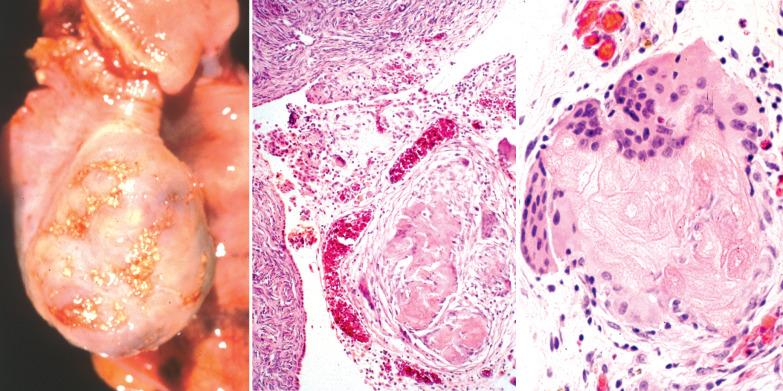
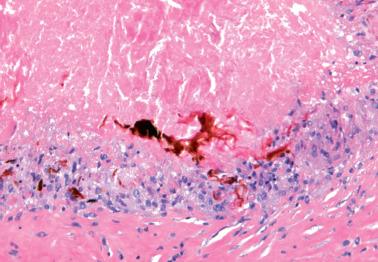
Nodular, plaque-like, or more extensive collections of histiocytes are occasionally encountered as a nonspecific peritoneal inflammatory response. They may be more commonly associated with ovarian rather than other intra-abdominal tumors. The lesions may be visible intraoperatively but are more commonly a microscopic finding.
Microscopically there is typically a monotonous population of histiocytes with moderate amounts of pale eosinophilic cytoplasm. Some nuclei may be reniform and/or contain a groove (resembling Langerhans’-type histiocytes) or have ‘raisinoid’ nuclear contours (Michal et al.).
Admixed mesothelial cells (‘nodular histiocytic/mesothelial hyperplasia’) and lymphocytes (predominantly T cells) may also be present. Staining for cytokeratin can highlight the mesothelial cells whereas the histiocytes show strong diffuse staining for CD68, CD163, CD4, and CD64 (Michal et al.).
Awareness of this finding, and if necessary, immunostains, facilitate the diagnosis. We have seen a case in which peritoneal histiocytes were initially misinterpreted as metastatic granulosa cell tumor.
Peritoneal collections of foamy and/or ceroid-rich histiocytes (usually a microscopic finding) can be a response to endometriosis or a peritoneal decidual reaction.
Peritoneal ‘melanosis’ is a rare finding, usually associated with an ovarian dermoid cyst, some with preoperative rupture. Rare cases have also been associated with a serous or mucinous cystadenoma or metastatic malignant melanoma to the peritoneum.
Tan to black peritoneal staining or pigmented tumor-like nodules involving the pelvic peritoneum and omentum may mimic metastatic tumor at laparotomy. The dermoid cysts also may have pigmentation of their contents and lining that may be associated with foci of ulcerated gastric mucosa.
The peritoneal lesions consist of pigment-laden histiocytes. Jaworski et al. found that the pigment lacked the histochemical features of both melanin and hemosiderin, but was rich in iron. In our experience, the pigment frequently is proven to be melanin with special stains, but occasional cases are of uncertain nature.
Awareness of this lesion and the histiocytic nature of the pigmented cells facilitate distinction from metastatic malignant melanoma.
Peritoneal pigmentation may also occur following enteroscopic tattooing with India ink. In one case, a subsequent laparoscopy revealed multifocal black speckling of the peritoneum, the appearance mimicking endometriosis. Biopsy revealed black pigment within multinucleated histiocytes.
Mucicarminophilic histiocytosis is characterized by histiocytes that contain polyvinylpyrrolidone (PVP), a substance used as a blood substitute.
The histiocytes are found within and outside the female genital tract, including pelvic lymph nodes and the omentum.
The vacuolated basophilic to lavender cytoplasm and an eccentric nucleus may suggest signet-ring cell adenocarcinoma. The histiocytes are mucicarminophilic but unlike neoplastic signet-ring cells, are PAS-negative. Additionally, cytokeratin stains are negative.
A peritoneal reaction similar to mucicarminophilic histiocytosis has been described secondary to oxidized regenerated cellulose, a topical hemostatic agent. The histiocytes have abundant, granular, basophilic, and mucicarminophilic cytoplasm.
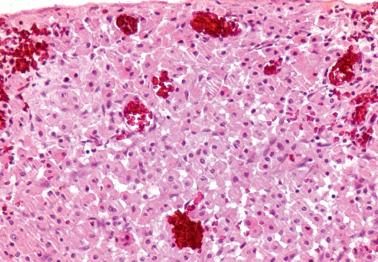
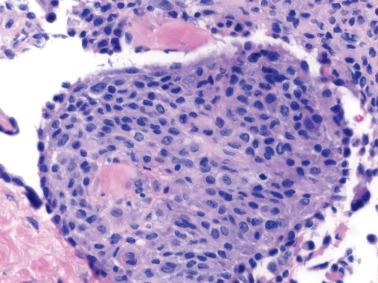
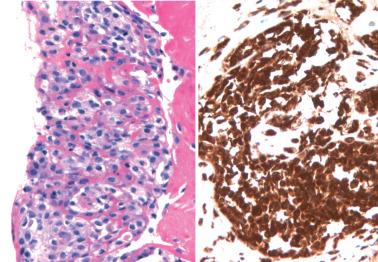
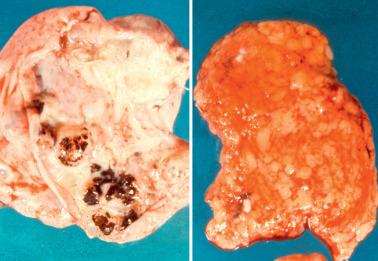
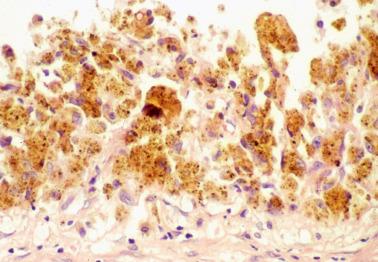
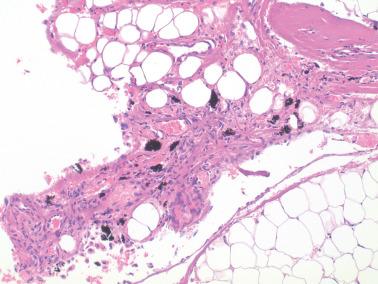
Reactive peritoneal fibrosis is a common nonspecific response, most commonly to peritonitis, a surgical procedure, or endometriosis. Fibrous adhesions are a common complication. Occasionally the fibrosis can take the form of well-circumscribed fibrous nodules.
Localized hyaline plaques are a common incidental finding on the splenic capsule, and peritoneal fibrous thickening can occur in patients with hepatic cirrhosis and ascites.
Sclerosing peritonitis, which is a reactive proliferation of the submesothelial mesenchymal cells to a variety of stimuli, often encases the small bowel (‘abdominal cocoon’) causing bowel obstruction. The fibrosis may involve the muscularis layers in rare cases (‘mural fibrosis’) (Hauglustaine et al.)
The causes or associations include practolol therapy, chronic ambulatory peritoneal dialysis, peritoneovenous shunts, bacterial or mycobacterial infection, sarcoidosis, carcinoid syndrome, familial Mediterranean fever, foreign materials, lupus erythematosus, and luteinized thecomas (thecomatosis) ( Chapter 16 ). Some cases are idiopathic.
Several patients with sclerosing peritonitis have been successfully treated by antiestrogens and/or GnRH agonists.
Sclerosing mesenteritis (mesenteric panniculitis, mesenteric lipodystrophy) typically presents as a localized mass, usually in the small bowel mesentery. Varying degrees of fibrosis, inflammation, and fat necrosis are present.
Some cases have been IgG4-related (Abe et al., ). IgG4-related disease is a systemic disease with elevated levels of serum IgG4 and multiorgan involvement (including the retroperitoneum and mesentery) by a dense lymphoplasmacytic infiltrate, storiform-type fibrosis, and obliterative phlebitis.
However, Avincsal et al. concluded that conclusive IgG4-related cases with all the characteristic features (high serum IgG4 levels, tissue IgG4 elevation, multi-organ involvement, response to glucocorticoid therapy) have not yet been reported.
IgG4-related cases should be distinguished from idiopathic sclerosing mesenteritis and idiopathic retroperitoneal fibrosis.
Reactive nodular fibrous pseudotumor.
Yantiss et al. applied this term to lesions that involved the gastrointestinal tract or mesentery in adults. They were single or multiple and up to 6 cm in size. Some infiltrated the bowel wall, but all had a benign course.
Microscopic examination revealed a hypocellular proliferation of fibroblasts, collagen, and sparse mononuclear inflammatory cells. The cells were variably positive for vimentin, CD117, actins (MSA, SMA), and desmin, but not CD34 or ALK-1.
The differential diagnosis of reactive fibrous proliferations includes desmoplastic mesothelioma.
Features favoring or indicating the latter include nuclear atypia, necrosis, organized patterns of collagen deposition (fascicular, storiform), frankly sarcomatoid areas, and invasion.
Immunoreactivity for cytokeratins, calretinin, and D2-40 also favor mesothelioma as does immunohistochemical loss of BAP1 (see below). Some reactive fibrous proliferations, however, may contain submesothelial spindle cells with a mesothelial immunophenotype.
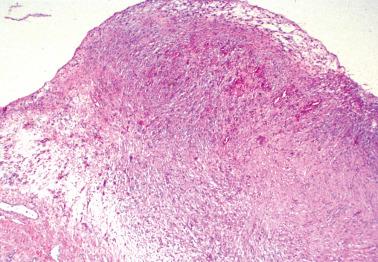
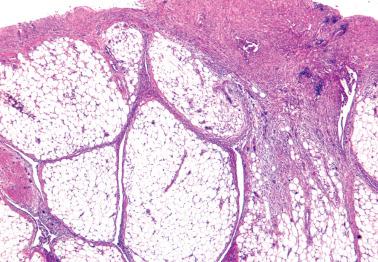
Amniotic fluid spilled at cesarean section containing vernix caseosa (keratin, squames, sebum, lanugo hair) can result in peritonitis that rarely mimics an acute abdomen. The histologic findings include a mixed inflammatory infiltrate (neutrophils, histiocytes including giant cells) and anucleate fetal squamous cells.
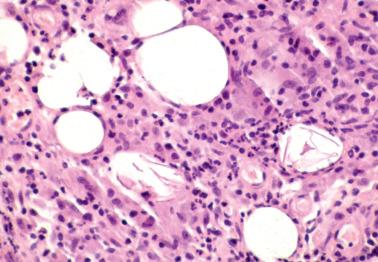
Intestinal perforation with release of meconium (containing bile, pancreatic, and intestinal secretions) can result in a peritoneal inflammatory response. Intravascular spread of meconium may also occur.
Calcified foci (amorphous, granular, or psammomatous) are surrounded by histiocytes including foreign-body giant cells and loose myxoid adhesions (Forouhar). Occasionally, the only residue is a sharply demarcated calcified nodule that may have a fibrous pseudocapsule (Olnick and Hatcher).
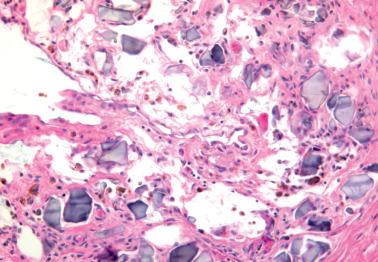
Pulse granulomas (PGs) can form a tumor-like peritoneal mass (usually on the bowel serosa) and represent a reaction to food particles reaching the serosa as a result of mucosal trauma (Nowacki et al.).
Histologic examination reveals hyaline ribbons and rings (somewhat reminiscent of a corpus albicans), inflammation, foreign-body giant cells, calcification, stellate fibrosis, and food particles.
Hyaline-predominant PGs can mimic amyloid, cellular-predominant PGs can mimic spindle cell neoplasms, and fibrotic PGs can mimic sclerosing mesenteritis.
This process is a common response to chronic effusions, inflammation (such as pelvic inflammatory disease), endometriosis, and ovarian tumors. Occasionally it is confined to a hernia sac as a result of trauma or incarceration.
Most commonly the process is an incidental microscopic finding but occasionally may be associated with adhesions, granularity, or small nodules.
Microscopic examination reveals sheets, nests, cords, tubules, and papillae that are usually on the surface. Endophytic growth can result in linear, often parallel or irregular arrays of reactive mesothelial cells, often forming tubules, within reactive fibrous tissue or the walls of ovarian tumors, endometriotic cysts, and peritoneal inclusion cysts (see below).
The papillae vary from tall and broad-based to delicate and filiform to small and serous-like. These findings, particularly if associated with foci of microcalcification, may raise concern for a low-grade serous neoplasm.
Aggregates of mesothelial cells may lie within spaces that in some cases appear to be artifactual but in other cases are intravascular.
The cells usually have appreciable eosinophilic cytoplasm, mild to moderate nuclear atypia, multinucleation, and occasional mitotic figures. The mesothelial cells may contain cytoplasmic vacuoles that stain for acid mucin (predominantly hyaluronic acid), and when prominent may result in signet-ring-like appearance.
Uncommon findings include a deciduoid morphology (potentially mimicking deciduoid mesothelioma; see Malignant Mesothelioma ), eosinophilic strap-shaped cells resembling rhabdomyoblasts, and psammoma bodies.
Mesothelial cells in abdominal lymph nodes may be misinterpreted as metastatic tumor, especially in women with a known primary pelvic cancer. There may be concomitant mesothelial hyperplasia of the pelvic and abdominal peritoneum. The appearance of the cells on routine stains suggests the correct diagnosis, and can be confirmed by histochemical and immunohistochemical staining.
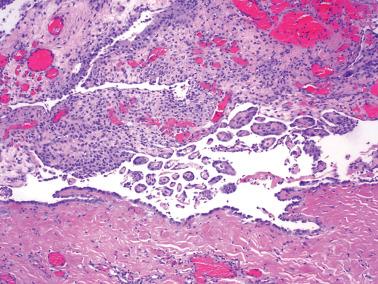
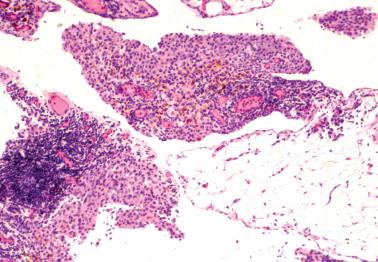
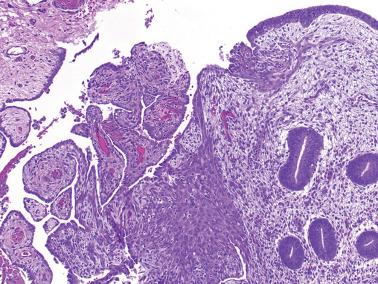


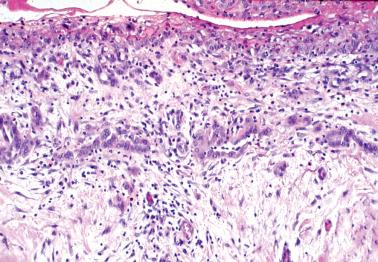

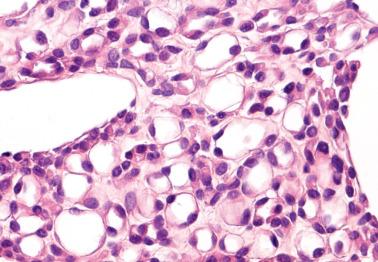
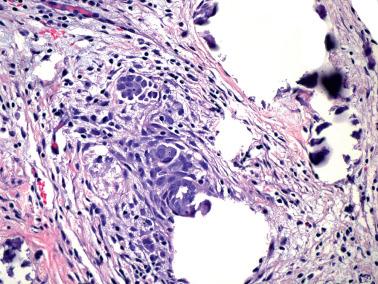
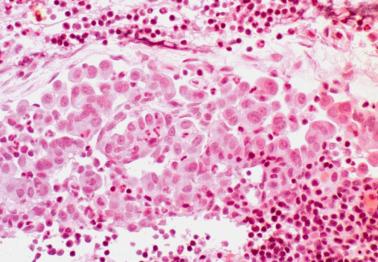
Peritoneal malignant mesothelioma (PMM) (see corresponding heading).
Features that favor or indicate PMM include grossly visible nodules, definite invasion, diffuse marked nuclear atypia, and necrosis. However, some of these features are often absent or present only focally within a PMM.
Reactive mesothelial cells, unlike PMMs, are typically positive for desmin and BAP1 (BRCA1-associated protein) but negative for EMA, IMP3, p53, GLUT-1, XIAP, and EZH2. EMA and IMP3 together are better than either marker alone (Chang et al.). GLUT-1 and IMP3 positivity strongly favors PMM, but negative expression does not exclude it; both markers are occasionally found in benign mesothelial proliferations.
Pillappa et al. found that loss of BAP1 expression in atypical mesothelial proliferations helps predict malignant mesothelioma.
Reactive mesothelial hyperplasias lack homozygous deletions of the 9p21 locus (that encodes deletions of p16/CDKN2A) by FISH that are present in PMMs (see latter heading).
Serous tumors of peritoneal or genital tract origin. Grossly visible ovarian or peritoneal tumor, columnar cells with or without cilia, neutral mucin, numerous psammoma bodies, and immunohistochemical markers for epithelial differentiation favor or establish the diagnosis of a serous tumor.
These are usually an incidental intraoperative finding. Single or multiple, small, thin-walled, translucent, unilocular cysts are attached to the peritoneum or an abdominal organ or are free-floating.
They have a smooth lining composed of a single layer of flattened, benign mesothelial cells, and yellow watery to gelatinous contents.
Most unilocular PICs are probably reactive (as with multilocular PICs; see below), whereas some in the mesocolon, small bowel mesentery, retroperitoneum, and splenic capsule may be developmental.
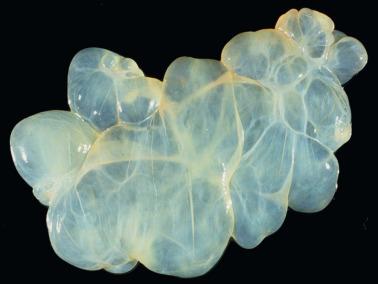
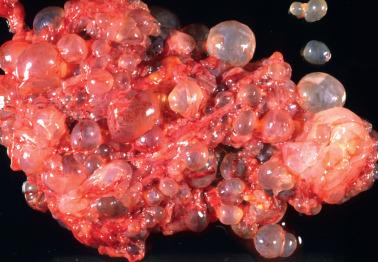
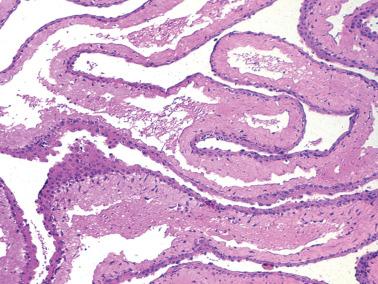
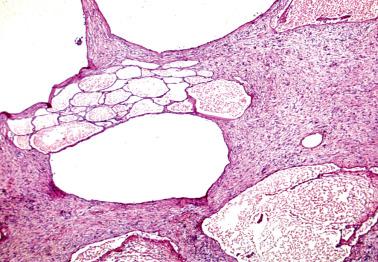
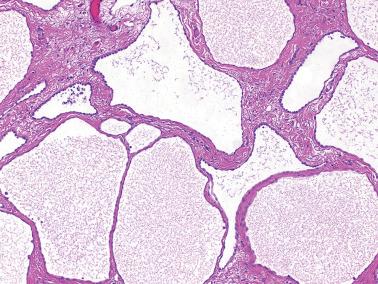
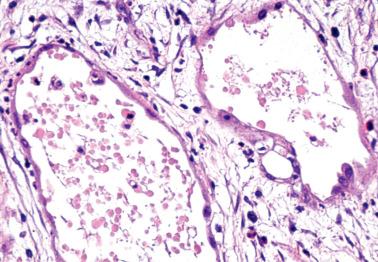
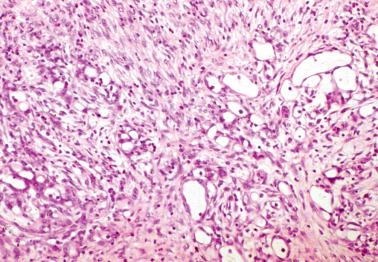
These lesions (MPICs), also referred to (inappropriately in our opinion) as ‘benign multicystic mesothelioma’, are usually associated with clinical manifestations, most commonly lower abdominal pain, a palpable mass, or both.
A history of a prior abdominal operation, pelvic inflammatory disease, or endometriosis has been found in up to 85% of patients in some studies, suggesting that most MPICs are reactive and a result of adhesions. Indeed, in some cases it may be arbitrary whether a process is best categorized as florid adhesions or an MPIC.
MPICs usually adhere to pelvic organs and may even simulate a cystic ovarian tumor on clinical examination, at laparotomy, or gross pathologic examination; the upper abdominal cavity, the retroperitoneum, or hernia sacs may also be involved. One MPIC with lymph node involvement has been reported.
The lesions may be large (up to 20 cm or rarely larger) with walls and septa often containing considerable amounts of fibrous tissue. Their contents may resemble those of the unilocular cysts or be serosanguineous or bloody.
The cysts are typically lined by a single layer of flat to cuboidal, occasionally hobnail-shaped, mesothelial cells with nuclear features that vary from bland to mildly atypical. Squamous metaplasia is occasionally seen.
Unusual findings include intracystic papillae or cribriform patterns, and mural proliferations of typical or atypical mesothelial cells arranged singly, as gland-like structures or nests, or in patterns resembling those in adenomatoid tumors. Occasional vacuolated mesothelial cells in the stroma may simulate signet-ring cells. Rare MPICs have contained foci of endometriosis.
The septa typically consist of fibrovascular connective tissue, but occasionally contain a marked acute and chronic inflammatory cell infiltrate, abundant fibrin, granulation tissue, and evidence of recent and remote hemorrhage.
The mesothelial cells are typically immunoreactive for calretinin, and in occasional cases, ER, PR, or both.
Follow-up has not disclosed malignant behavior. ‘Recurrences’ develop in as many as half the cases months to many years postoperatively, although these are often likely due to newly formed adhesions. Some MPICs have responded to treatment with GnRH agonists, oral contraceptive, or tamoxifen.
The differential diagnosis of MPICs includes:
Florid adhesions (see above). MPICs should be grossly evident as one or more cystic masses.
Multilocular cystic lymphangiomas. Differential features include typical occurrence in children (especially boys), usual extrapelvic location (small intestine mesentery, omentum, mesocolon, retroperitoneum), chylous fluid contents, mural lymphoid cells and smooth muscle, and endothelial lining cells.
Multicystic adenomatoid tumor. In contrast to MPICs, these tumors typically involve the myometrium, have a prominent component of smooth muscle, contain foci of typical adenomatoid tumor, and lack prominent inflammation. Serosal-based examples may be particularly challenging.
True multicystic mesothelioma (see Malignant Mesothelioma ).
Splenosis, which results from implantation of splenic tissue, is typically an incidental finding at laparotomy or autopsy months to years after splenectomy for traumatic splenic rupture. In rare cases, pelvic pain and/or a mass are present.
A few to innumerable, red–blue, peritoneal nodules, up to 7 cm in diameter, are scattered throughout the abdominal, and less commonly, the pelvic cavity.
The intraoperative appearance may mimic endometriosis, benign or malignant vascular tumors, or metastatic cancer.
The differential includes splenic–gonadal fusion (see Chapter 12 ).
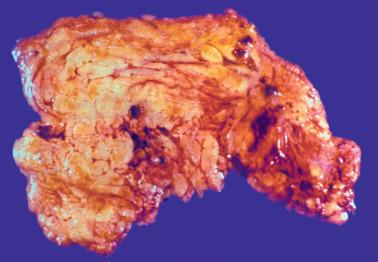
Implants of trophoblast on the pelvic or omental peritoneum can occur after a ruptured tubal pregnancy, and are more common with a distal tubal implantation.
The implants may also be a complication of the operative treatment of tubal pregnancies and are more common in cases managed by salpingotomy than salpingectomy.
An initial postoperative decline in the serum hCG level is followed by a rising level, abdominal pain, and in some cases, intra-abdominal hemorrhage.
Microscopic examination of the implants reveals viable trophoblastic tissue (that may include chorionic villi) and rarely, fetal parts. Occasionally, the lesions resemble a placental site nodule or plaque ( Chapter 10 ).
The differential diagnosis is with rare cases of peritoneal trophoblastic gestational disease (see Rare Primary Tumors ).
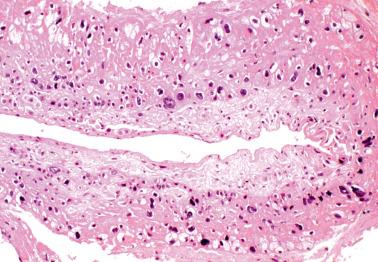
Torsion, infarction, and subsequent calcification of an appendix epiploica can result in a firm to hard mass or occasionally a cystic lesion attached or loose in the peritoneal cavity.
In the late stages, layers of hyalinized connective tissue surround a central necrotic and calcified zone in which infarcted adipose tissue in usually recognizable.
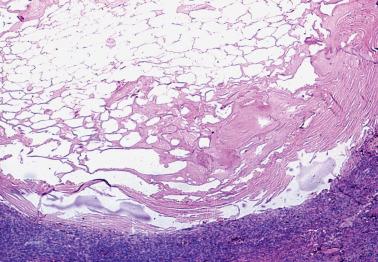
Rare cases of microscopic extraovarian sex cord proliferations have been described in subperitoneal tissues (appendiceal serosa, pelvic side wall, para-ovarian connective tissue, periovarian adhesions) similar to those described in the fallopian tube (see Chapter 11 , Rare Ectopic Tissues).
Cartilaginous metaplasia of the peritoneum has been reported rarely, usually as one or more incidentally discovered nodules in patients who have had previous abdominal surgery. The nodules are usually <2 cm and consist of mature hyaline cartilage.
Spillage with peritoneal/ovarian implantation of gallstones is a complication of laparoscopic treatment of cholelithiasis that may result in abdominal pain and/or a nidus for granulomatous inflammation or infection.
Ardakani et al. reported five cases of extramedullary hematopoiesis within organizing peritoneal hematomas in women with gynecologic disorders. The hematopoietic elements included erythroid precursors (5 cases), granulocytic precursors (2 cases), and megakaryocytes (3 cases). None of the patients had a hematologic disorder at presentation or on follow-up.
Dill et al. reported a case of tophaceous gout in the pelvis of a 36-year-old woman who presented with abdominal pain but no history or physical evidence of gout. Laparoscopy revealed multiple firm, white, pelvic nodules of eosinophilic, partially calcified material containing refractile needle-shaped crystals consistent with urate crystals.
This benign tumor of mesothelial origin rarely arises from extragenital peritoneum, such as the omentum or mesentery, but is much more commonly encountered in the myometrium and fallopian tube.
Its pathologic features are discussed in Chapter 10 .
Evaluating the literature on tumors reported as well-differentiated papillary mesothelioma (WDPM) is difficult because morphologically identical foci can be seen in unequivocal malignant mesotheliomas. Overlap between the two tumors is further indicated by the presence of invasion in some tumors reported as WDPMs. We use the designation WDPM sparingly, especially if a mesothelioma is multifocal and/or bulky, findings that are prognostically adverse.
Given the variable morphology of mesotheliomas, thorough sampling is crucial, and when multiple lesions are present, they should each ideally be removed for microscopic examination. These caveats being noted, the features of WDPM below are based on the published literature.
WDPMs are uncommon; 80% of them have occurred in females, who are in the reproductive and postmenopausal age groups. They are usually an incidental finding at laparotomy, but rare tumors are associated with abdominal pain or ascites. There is no apparent association with asbestos exposure.
Solitary or multiple, grey to white, firm, usually papillary, nodular, or rarely cystic lesions up to 2 cm in size involve the abdominal and/or pelvic peritoneum. The most commonly involved sites are the omentum, cul-de-sac, colonic serosa, small bowel mesentery, and uterine serosa.
Fibrous papillae are lined by a single layer of flattened to cuboidal mesothelial cells with occasional basal vacuoles. The nuclear features are benign and mitotic figures are rare or absent. Solitary lesions with these features have been clinically benign.
Other patterns are tubulopapillary, adenomatoid tumor-like areas, branching cords, sheets, nests, or individual cells. The stroma may be extensively fibrotic. Multinucleated stromal giant cells and/or psammoma bodies are rarely present.
reported the presence of invasion in WDPMs, most of which were in females, multiple, and peritoneal. The invasive foci varied from simple glands invading the stalks of papillae to solid foci with higher cytologic grade. The tumors were negative for p16 deletion by FISH, but two-thirds had abnormal karyotypes. Invasion, however, should always raise concern for a conventional mesothelioma particularly when the lesions are multiple.
A potential pitfall in diagnosis of WDPM is their aberrant strong diffuse nuclear staining with PAX8 in >50% of tumors (Banet et al., Xing et al.). Banet et al. found stronger staining with polyclonal (vs monoclonal) antibodies, and that smaller WDPMs (1–3 mm) with fibrotic cores and bland mesothelial cells were PAX8 negative.
. have recently found that WDPMs are genetically defined by mutually exclusive mutations in TRAF7 and CDC42 .
On follow-up, typical WDPMs are clinically indolent, although rare tumors recur or persist. In contrast, recurrences (multiple in 50%) developed in 40% of WDPMs with invasive foci, but were rarely fatal. Follow-up of patients with WDPMs is prudent because of occult multifocal lesions, possible recurrences, or initial misdiagnosis of an undersampled malignant mesothelioma.
The main tumor in the differential diagnosis is malignant mesothelioma (see below).
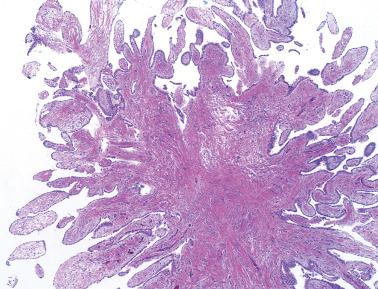
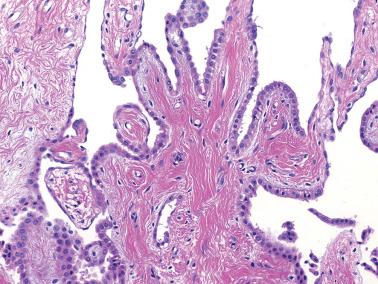
Become a Clinical Tree membership for Full access and enjoy Unlimited articles
If you are a member. Log in here